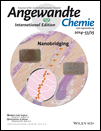Flow-Through Synthesis on Teflon-Patterned Paper To Produce Peptide Arrays for Cell-Based Assays†
We thank Kevin R. Kalin for his help with the synthesis of polyalanine on paper and flow-through imaging. This research was sponsored by the Alberta Glycomics Centre, the University of Alberta Startup Funds and SENTINEL Bioactive Paper Network. Infrastructure support has been provided by the Canada Foundation for Innovation (CFI).
Graphical Abstract
On the same page: The patterned deposition of Teflon on paper creates barriers resistant to organic solvents. The solvents confined by the pattern flow through the paper at a controlled flow-rate, which permits the flow-through synthesis of 96 peptides in parallel on one sheet of paper. The resulting peptide arrays can be used to perform cell-based assays and discover 3D materials that support cell adhesion and growth.
Abstract
A simple method is described for the patterned deposition of Teflon on paper to create an integrated platform for parallel organic synthesis and cell-based assays. Solvent-repelling barriers made of Teflon-impregnated paper confine organic solvents to specific zones of the patterned array and allow for 96 parallel flow-through syntheses on paper. The confinement and flow-through mixing significantly improves the peptide yield and simplifies the automation of this synthesis. The synthesis of 100 peptides ranging from 7 to 14 amino acids in length gave over 60 % purity for the majority of the peptides (>95 % yield per coupling/deprotection cycle). The resulting peptide arrays were used in cell-based screening to identify 14 potent bioactive peptides that support the adhesion or proliferation of breast cancer cells in a 3D environment. In the future, this technology could be used for the screening of more complex phenotypic responses, such as cell migration or differentiation.





